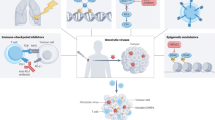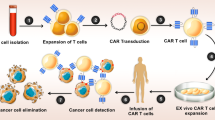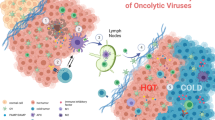Abstract
Oncolytic viruses (OVs) have shown great anti-cancer potential in animal models, but only modest success in early clinical trials. A better understanding of the mechanisms underlining OV efficacy is needed to resolve this discrepancy. In the clinic, OV therapy will likely be combined with traditional chemotherapy, underscoring the need to also evaluate the interactions between these therapeutic modalities. Here we show that combining Sindbis viral vector therapy with the topoisomerase inhibitor irinotecan (CPT-11) results in the long-term survival of about 35% of SCID mice bearing aggressively growing ES2 human ovarian cancer. Single-agent treatments did not result in long-term survival. Flow cytometry analysis, bioluminescent imaging and survival experiments revealed that Sindbis and CPT-11 utilize non-overlapping natural killer (NK)-cell-dependent and -independent anti-cancer mechanisms, respectively. Notably, the combinatorial therapy was only effective in the presence of NK cells. These results highlight the hidden role of immune cell activation in combinatorial cancer therapy involving OVs and provide a potential method for tackling tumor cell resistance to cancer therapy while limiting treatment-related side effects.
This is a preview of subscription content, access via your institution
Access options
Subscribe to this journal
Receive 12 print issues and online access
$259.00 per year
only $21.58 per issue
Buy this article
- Purchase on Springer Link
- Instant access to full article PDF
Prices may be subject to local taxes which are calculated during checkout

Similar content being viewed by others
References
Morton CL, Iacono L, Hyatt JL, Taylor KR, Cheshire PJ, Houghton PJ et al. Activation and antitumor activity of CPT-11 in plasma esterase-deficient mice. Cancer Chemother Pharmacol 2005; 56: 629–636.
Tseng JC, Levin B, Hurtado A, Yee H, Perez de Castro I, Jimenez M et al. Systemic tumor targeting and killing by Sindbis viral vectors. Nat Biotechnol 2004; 22: 70–77.
Prestwich RJ, Harrington KJ, Pandha HS, Vile RG, Melcher AA, Errington F . Oncolytic viruses: a novel form of immunotherapy. Expert Rev Anticancer Ther 2008; 8: 1581–1588.
Granot T, Venticinque L, Tseng JC, Meruelo D . Activation of cytotoxic and regulatory functions of NK cells by Sindbis viral vectors. PLoS One 2011; 6: e20598.
Stubdal H, Perin N, Lemmon M, Holman P, Bauzon M, Potter PM et al. A prodrug strategy using ONYX-015-based replicating adenoviruses to deliver rabbit carboxylesterase to tumor cells for conversion of CPT-11 to SN-38. Cancer Res 2003; 63: 6900–6908.
Liu LF, Desai SD, Li TK, Mao Y, Sun M, Sim SP . Mechanism of action of camptothecin. Ann NY Acad Sci 2000; 922: 1–10.
Morris EJ, Geller HM . Induction of neuronal apoptosis by camptothecin, an inhibitor of DNA topoisomerase-I: evidence for cell cycle-independent toxicity. J Cell Biol 1996; 134: 757–770.
Vivier E, Tomasello E, Baratin M, Walzer T, Ugolini S . Functions of natural killer cells. Nat Immunol 2008; 9: 503–510.
Gonzalez S, Lopez-Soto A, Suarez-Alvarez B, Lopez-Vazquez A, Lopez-Larrea C . NKG2D ligands: key targets of the immune response. Trends Immunol 2008; 29: 397–403.
Xu Y, Villalona-Calero MA . Irinotecan: mechanisms of tumor resistance and novel strategies for modulating its activity. Ann Oncol 2002; 13: 1841–1851.
Acknowledgements
We thank Dr Christine Pampeno and Vincent DiGiacomo for critical reading of this manuscript. This work was supported by the US Public Health grants CA100687 from the National Cancer Institute, National Institutes of Health and Department of Health and Human Services. Funding was also provided by a gift from the Litwin Foundation and a Research and License agreement between NYU and CynVec.
Author information
Authors and Affiliations
Corresponding author
Ethics declarations
Competing interests
The contents of this paper are being utilized for a patent. According to the rules and regulations of New York University School of Medicine, if this patent is licensed by a third party, the authors (DM, TG) may receive benefits in the form of royalties or equity participation.
Rights and permissions
About this article
Cite this article
Granot, T., Meruelo, D. The role of natural killer cells in combinatorial anti-cancer therapy using Sindbis viral vectors and irinotecan. Cancer Gene Ther 19, 588–591 (2012). https://doi.org/10.1038/cgt.2012.33
Received:
Revised:
Accepted:
Published:
Issue Date:
DOI: https://doi.org/10.1038/cgt.2012.33



